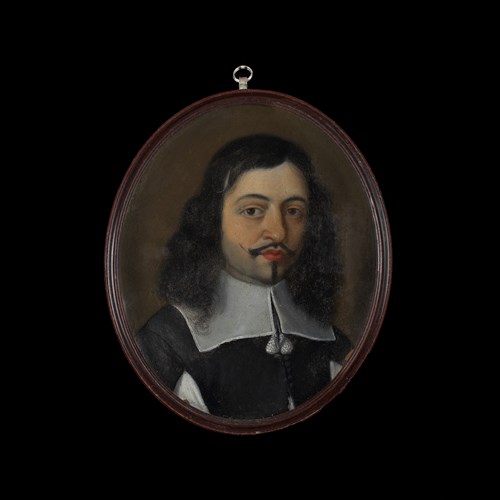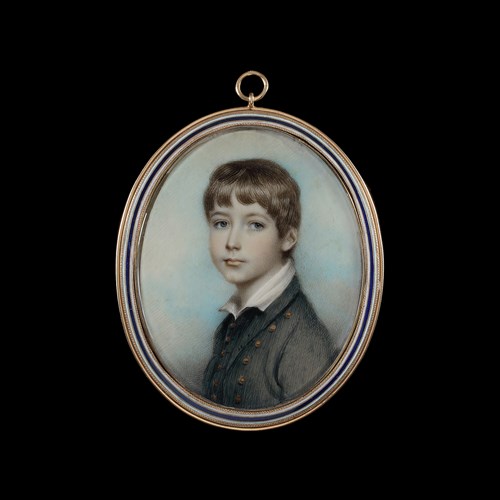Marketplace
Portrait miniature of a young Girl with folded arms, wearing a white dress and a black sash
RICHARD COSWAY
Portrait miniature of a young Girl with folded arms, wearing a white dress and a black sash
The Limner Company : Portrait Miniature
Date 1789
Medium Watercolour on ivory
Dimension 7.3 cm (2⁷/₈ inches)
This portrait of probably depicts a young girl, as although for centuries young children of both sexes had worn gowns until approximately the age of seven (when boys were ‘breeched’, i.e. adopted men’s clothes), the fashion for children had recently changed. In the 1780s, breeching began to happen earlier, at around the age of three or four, when boys would wear a transitional ensemble in imitation of men’s clothes known as a ‘skeleton suit’.[1] At around the age of 10 boys began to wear clothes more closely resembling the suits of grown men, but still looser, more practical versions. Girls, however, tended not to transition into adult forms of dress until around the age of 12 - their later progression from infant clothing indicative of girls’ dependency on their parents. The gowns of young children might also include leading strings – strips of fabric handing from the shoulders which acted like reigns. These too, were worn much later by girls than boys, especially in the first half of the eighteenth century when it was not uncommon for girls to still be wearing leading strings in their teens.
The eighteenth-century developments in childrenswear were largely brought about by the Enlightenment. John Locke’s Some Thought Concerning Education, published in 1693 but influential throughout the eighteenth century, and Jean Jacques Rousseau’s Emile, or On Education (1762), both advocated for more freedom and informality in childhood than had previously been considered morally acceptable. This progressive philosophy also concerned clothing.[2]
A broad sash tied at the waist in a large bow was a typical feature of children’s dress and were paired with both gowns and skeleton suits. Sashes tended to be bright in colour and blue was particularly popular. The black example worn here was less typical and may represent mourning.
Richard Cosway was one of the greatest miniaturists of the late-eighteenth and early nineteenth centuries - the period considered by many to be ‘the heyday’ of British miniature painting. In around 1786, a few years prior to the date of the present portrait, Cosway had been appointed miniaturist to the Prince of Wales (later George IV), who was also a close friend. Cosway was the most sought-after miniaturist in London, and, alongside royalty, he could count the most famous names of the late eighteenth-century among his clientele, including prime ministers, actors and society beauties Georgiana, Duchess of Devonshire (1757-1806), and Emma, Lady Hamilton (1765-1815).
[1] See for example the portrait miniature of an unknown boy, perhaps Sir Frederick Augustus D'Este (1794-1848), by Richard Cosway – Victoria and Albert Museum [P.7-1941] https://collections.vam.ac.uk/item/O75276/unknown-boy-perhaps-sir-frederick-portrait-miniature-cosway-richard-ra/
[2] Reynolds, A., Style & Society: Dressing the Georgians (Royal Collection Trust), 2023, p.143
The eighteenth-century developments in childrenswear were largely brought about by the Enlightenment. John Locke’s Some Thought Concerning Education, published in 1693 but influential throughout the eighteenth century, and Jean Jacques Rousseau’s Emile, or On Education (1762), both advocated for more freedom and informality in childhood than had previously been considered morally acceptable. This progressive philosophy also concerned clothing.[2]
A broad sash tied at the waist in a large bow was a typical feature of children’s dress and were paired with both gowns and skeleton suits. Sashes tended to be bright in colour and blue was particularly popular. The black example worn here was less typical and may represent mourning.
Richard Cosway was one of the greatest miniaturists of the late-eighteenth and early nineteenth centuries - the period considered by many to be ‘the heyday’ of British miniature painting. In around 1786, a few years prior to the date of the present portrait, Cosway had been appointed miniaturist to the Prince of Wales (later George IV), who was also a close friend. Cosway was the most sought-after miniaturist in London, and, alongside royalty, he could count the most famous names of the late eighteenth-century among his clientele, including prime ministers, actors and society beauties Georgiana, Duchess of Devonshire (1757-1806), and Emma, Lady Hamilton (1765-1815).
[1] See for example the portrait miniature of an unknown boy, perhaps Sir Frederick Augustus D'Este (1794-1848), by Richard Cosway – Victoria and Albert Museum [P.7-1941] https://collections.vam.ac.uk/item/O75276/unknown-boy-perhaps-sir-frederick-portrait-miniature-cosway-richard-ra/
[2] Reynolds, A., Style & Society: Dressing the Georgians (Royal Collection Trust), 2023, p.143
Date: 1789
Medium: Watercolour on ivory
Signature: Inscribed on backing card, ‘R:dus Cosway / R. A. / Primarius Pictor / Serenissimi Walliae / Principis / Pinxit / 1789’
Dimension: 7.3 cm (2⁷/₈ inches)
Provenance: Leo R. Schidlof (1886-1996), Vienna, by 1927;
Christie's London, 10 November 1993, lot 52;
Sotheby’s London, The Pohl-Ströher Collection of Portrait Miniatures Part I, 6 December 2018;
Private Collection, UK.
Plus d'œuvres d'art de la Galerie





, wearing lawn collar, his hair long and curled_T638688390047901881.jpg?width=500&height=500&mode=pad&scale=both&qlt=90&format=jpg)
-Two portraits of Gentlemen one wearing black doublet with white lawn collar and tassels the other also in black dou_T638729653706802020.jpg?width=500&height=500&mode=pad&scale=both&qlt=90&format=jpg)


